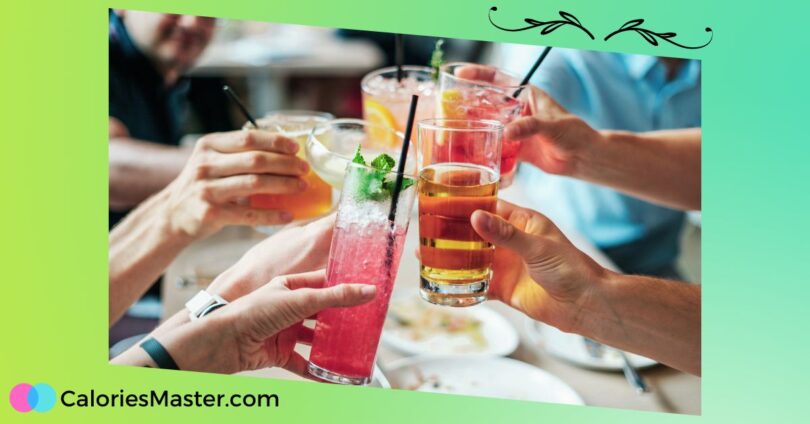Low calorie alcoholic drinks have become increasingly popular as people look for ways to enjoy a night out without piling on the pounds. While it’s no secret that alcohol can be high in calories, there are ways to indulge in a drink or two without sabotaging your diet.
When it comes to low calorie alcoholic drinks, there are plenty of options available. From light beers to wine spritzers, there are a variety of drinks that can help you enjoy a night out without consuming too many calories.
However, it’s important to remember that moderation is key, and even low calorie drinks can add up if you’re not careful.
In this article, we’ll explore some of the best low-calorie alcoholic drinks available, as well as tips for drinking wisely without gaining weight.
Whether you’re looking for a refreshing cocktail or a light beer, we’ll provide you with all the information you need to make smart choices when it comes to drinking and maintaining a healthy lifestyle.
Understanding Calories in Alcohol
Alcohol is a source of empty calories, which means it contains calories but has little to no nutritional value. The caloric value of alcohol is derived from the sugar and carbohydrates present in it. Therefore, consuming alcohol in large quantities can lead to weight gain and other health problems.
Alcohol Content and Caloric Value
The amount of calories in an alcoholic drink depends on its alcohol content. The higher the alcohol content, the more calories the drink contains. For instance, a pint of beer with 5% alcohol contains about 215 calories, while a pint of beer with 8% alcohol contains around 345 calories.
The following table shows the approximate calorie content of different types of alcoholic drinks:
| Type of Drink | Serving Size | Approximate Calories |
|---|---|---|
| Beer (5% alcohol) | Pint | 215 |
| Beer (8% alcohol) | Pint | 345 |
| Wine (red or white) | 175ml glass | 130 |
| Spirits (gin, vodka, whisky, etc.) | Single measure (25ml) | 55 |
The Role of Mixers
Mixers can significantly increase the calorie content of an alcoholic drink. Sugary mixers such as fruit juices, soda, and tonic water can add a substantial amount of calories to a drink. For example, a gin and tonic made with regular tonic water can contain up to 200 calories per serving.
To reduce the calorie content of an alcoholic drink, it is advisable to use low-calorie mixers such as diet soda, soda water, or fresh lime juice. These mixers contain fewer calories and can help keep the drink’s overall calorie count low.
In conclusion, understanding the calorie content of alcoholic drinks and the role of mixers can help people make informed decisions about their alcohol consumption. By choosing low-calorie drinks and mixers, people can enjoy alcoholic beverages without worrying about gaining weight.
Selection of Low Calorie Alcoholic Drinks
When it comes to drinking alcohol, it’s important to choose drinks that won’t derail your healthy eating goals. Fortunately, there are plenty of low calorie alcoholic drinks to choose from. Here are some options:
Light Beers
Light beers are a popular choice for those looking to cut calories while still enjoying a cold brew. These beers typically have fewer calories and less alcohol than regular beers. Some popular light beer options include:
- Bud Light: 110 calories per 12 oz. serving
- Coors Light: 102 calories per 12 oz. serving
- Corona Light: 99 calories per 12 oz. serving
Dry Wines
Dry wines are a good option for those who prefer wine over beer or spirits. Dry wines are lower in sugar and calories than sweet wines. Some popular dry wine options include:
- Pinot Grigio: 122 calories per 5 oz. serving
- Sauvignon Blanc: 120 calories per 5 oz. serving
- Cabernet Sauvignon: 120 calories per 5 oz. serving
Spirits and Mixers
Spirits and mixers can be higher in calories than beer and wine, but there are still some lower calorie options to choose from. Here are some ideas:
- Vodka soda: 97 calories per 1.5 oz. serving
- Gin and tonic: 148 calories per 8 oz. serving (use diet tonic water to cut calories)
- Rum and Diet Coke: 97 calories per 1.5 oz. serving
Overall, there are plenty of low calorie alcoholic drinks to choose from. It’s important to remember that moderation is key when it comes to alcohol consumption, and to always drink responsibly.
Drinking Habits for Weight Management
Learn about these habits for better weight management.
Portion Control
When it comes to drinking alcoholic beverages, portion control is key to managing weight. Opt for drinks with lower alcohol content and smaller serving sizes. For example, instead of a pint of beer or a large glass of wine, choose a half pint or a small glass of wine.
Another way to control portions is to alternate between alcoholic and non-alcoholic drinks. This not only helps with weight management but also keeps you hydrated and reduces the risk of a hangover.
Timing of Consumption
The timing of alcohol consumption can also affect weight management. It is recommended to have drinks with a meal or snack rather than on an empty stomach. This slows down the absorption of alcohol and reduces the risk of overindulging.
It is also important to avoid drinking late at night or before bed. Alcohol disrupts sleep patterns and can lead to poor-quality sleep, which in turn can affect weight management.
By following these simple habits, it is possible to enjoy alcoholic drinks without gaining weight. Remember to always drink responsibly and in moderation.
Additional Tips for Healthier Alcohol Consumption
Here are some more tips:
Hydration and Alcohol
Staying hydrated is crucial when consuming alcohol. Alcohol is a diuretic, meaning it increases urine production and can lead to dehydration. Dehydration can cause headaches, dizziness, and fatigue, which can make it difficult to enjoy a night out.
To avoid dehydration, it is recommended to drink a glass of water between alcoholic drinks. This will help keep the body hydrated and reduce the risk of negative side effects.
Balancing Diet and Drinking
Drinking alcohol can add extra calories to one’s diet, which can lead to weight gain. It is important to balance alcohol consumption with a healthy diet.
Choosing low-calorie alcoholic drinks such as wine, light beer, or spirits mixed with low-calorie mixers can help reduce the number of calories consumed. Additionally, it is recommended to avoid sugary mixers and snacks while drinking, as they can add unnecessary calories.
Here are some additional tips for balancing diet and drinking:
- Eat a healthy meal before drinking to reduce the likelihood of overeating while drinking.
- Choose lower calorie options when consuming alcoholic drinks. For example, opt for a gin and tonic instead of a margarita.
- Avoid fast food or unhealthy snacks while drinking, as they can add unnecessary calories to your diet.
- Be mindful of portion sizes when drinking. Drinking in moderation can help reduce the number of calories consumed.
By following these tips, individuals can enjoy a night out without worrying about gaining weight or compromising their health.









